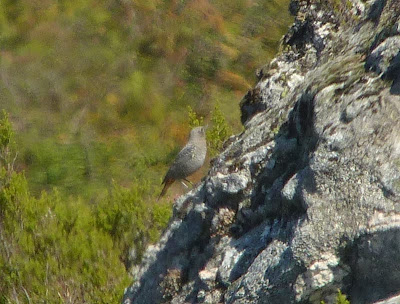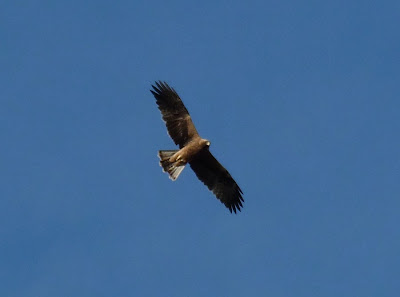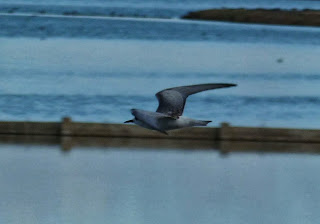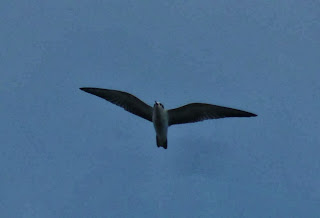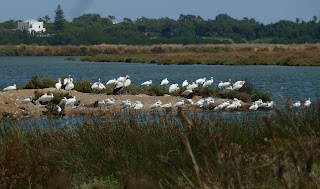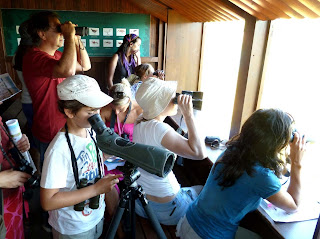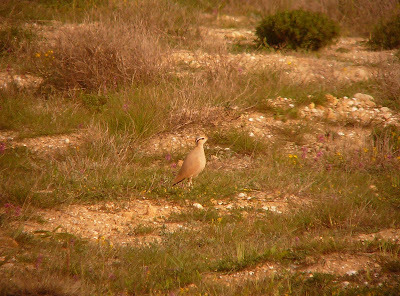Tuesday, December 31, 2013
Saturday, October 26, 2013
Black Storks, Eleanora's Falcons, Red Phalarope and Lesser Yellowlegs
...to name but a few of the treats seen during plenty of trips during this years autumn migration season here in the Algarve. Most wintering birds have arrived now. After a rainy period, the forecast is sunny now for the next couple of days.
We spend fantastic days in Sagres and nearby areas, witnissing the peak of the raptor migration, with over 100 Botted Eagles, dozens of Short-toed Eagles, Honey Buzzards, Egyptian Vultures and Bonelli's Eagles, Sparrow- and Goshawks, Hobbys and Eleanora's Falcons. At a nearby lagoon ("Martinhal") we found a juvenile Red Phalarope together with only a hand full of waders. The brackish pool was only about 10 x 20 m small, however, it is the only one of its kind in the area, therefore can attract interesting birds.
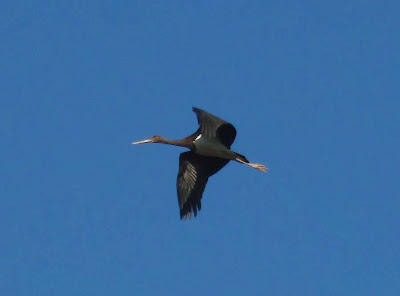 |
| A juvenile Black Stork (Ciconia nigra) passing by low above the watchpoint near the Cape of Sagres on October 8th, 2013. (All photos: GS) |
We spend fantastic days in Sagres and nearby areas, witnissing the peak of the raptor migration, with over 100 Botted Eagles, dozens of Short-toed Eagles, Honey Buzzards, Egyptian Vultures and Bonelli's Eagles, Sparrow- and Goshawks, Hobbys and Eleanora's Falcons. At a nearby lagoon ("Martinhal") we found a juvenile Red Phalarope together with only a hand full of waders. The brackish pool was only about 10 x 20 m small, however, it is the only one of its kind in the area, therefore can attract interesting birds.
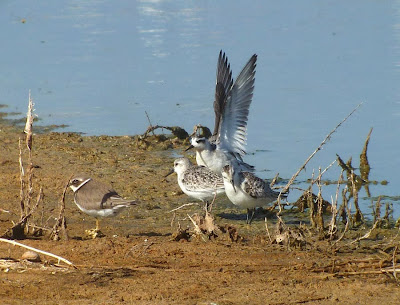 |
| Grey Phalarope (Phalaropus fulicarius) moulting into first winter plumage at Martinhal lagoon, Sagres, October, 9th 2013 (Photos: GS) |
Monday, September 30, 2013
White-winged Tern
I was delighted by this juvenile White-winged Tern (Chlidonias leucopterus) when visiting the seveage works just east of Faro on September, 13th. This eastern marsh-tern species is a rarity in Portugal, with about 20 records total to the present day. It was in company of an adult (moulting) Black Tern, many Ruff's and other wader species were also present at the location. Another highlight were no less than 3 Ospreys circling together. Bluethroat (adult female), Black-necked Grebes (3), Northern Pintail and Lapwing were firsts for the season.
Thursday, September 19, 2013
Sagres - autumn migration at the cape
During a day-tour to the cape-area near Sagres, we saw the following species (18th September 2013):
Spanish Imperial Eagle, Black Stork, Eleonora's Falcon, Bonelli's Eagle, Short-toed Eagle, Booted Eagle, Honey Buzzard, Peregrine, Gosh Hawk, Sparrow Hawk, Egyptian Vulture, Little Bustard, Red-billed Chough a.o.
Spanish Imperial Eagle, Black Stork, Eleonora's Falcon, Bonelli's Eagle, Short-toed Eagle, Booted Eagle, Honey Buzzard, Peregrine, Gosh Hawk, Sparrow Hawk, Egyptian Vulture, Little Bustard, Red-billed Chough a.o.
A great opportunity to visit the region and been introduced into its fantastic nature and birdlife is the upcoming Sagres Birdwatching-Festival, taking place October 4th to 6th 2013, organized by SPEA and Almargem.
Inscriptions for guided group visits, boat trips, walks, talks, workshops and many other activities are open. The program is available in English and Portuguese - for inscriptions and all Info visit:
Saturday, September 14, 2013
Great Shearwater today
Great Shearwater (Puffinus gravis) excellent views, 3 Ind., two birds swimming right next to the boat
Cory's Shearwater (Calonectris diomedea borealis) c. 35 Ind.
Sooty Shearwater (Puffinus griseus) 1 Ind., good views when showing up near boat and travelling on.
Shearwater sp. (Puffinus sp.) unidentified medium-sized SW travelling fast and distant, probably Balearic SW Puffinus mauretanicus.
Wilson's Storm Petrel (Oceanites oceanicus) 2 Ind., good views of one foreaging near boat.
European Storm Petrel (Hydrobates pelagicus) 3 Ind., plus two further, unidentified travelling SP.
Great Skua (Stercorarius skua) 4 Ind., very close views and cleptoparasitism.
Northern Gannet (Morus bassanus) c. 30 Ind.
A great trip despite the rain we catched during the trip - the first rain of the season. Next trip is scheduled for the 12th of October (still 4 vacancies) and one more around the 22nd of October, further trips on request, min. is 4 people to go out.
 |
| A Great Shearwater (Puffinus gravis) next to the boat. "His elegancy " in flight... |
Monday, September 9, 2013
Last weeks tours
My birding-week started early on Monday, 26th with a day-tour up to the Alentejo-plain, accompanied by an Australian birder and biologist and his German biologist friend. Bird of the day was an immature Rueppell's Vulture (Gyps rueppellii) feeding a on a carcass (sheep) in midst of well 150 Griffon Vultures and 5 Eurasian Black Vultures. On the digiscoping-shot I add here below, the difference in size (about 10% smaller and lighter built) and color (much darker and greyer brown, almost no contrast between mantle and wing feathers) are obvious. It is the third record of this African species I made in this region, the last one, made in company of a Swedish group in October 2012, I submitted to the Portuguese Rarities Committee (for other records, see here). I also know the species from the Strait of Gibraltar, where I saw it last September, near Algeciraz. There are also annual records for the Sagres-Peninsula now, made during the October/November passage of Griffon-flocks through the cape area.
Two days later, I have been in the area again, accompanied by an English photographer. The Black-bellied Sandgrouse were on our side that day, and we had them flying over close by. Also saw a large flock of about 100 Calandra Larks, the Iberian Grey- and Woodchat Shrikes, as expected, a juvenile Black Vulture and a few Griffons, Short-toed- and Booted Eagles and an impressive flock of Great Bustards flying by - a situation of which I am curious to see a photo... both, Black-eared Wheatears and Northern Wheatears were passing through, Little-ringed Plovers, Green- and Common Sandpipers and also some Black-winged Stilts were easily seen around small reservoirs in the area. A single Collared Pratincole was stopping over at a coastal lagoon on our way back. One remarkable situation I recall from the tour, was a Little Owl on a little wall beside the road, right next to the car, staying there and making the most extraordinary up- and down moves, expressing its state of alert (video would have been better!). I got one shot just with my compact camera through the car window (below).
Friday, 30th then, a morning in my "home-patch" here near Faro - with a French-American party of six. Willow- and Melodious Warblers, Spotted Flycatcher, Common Redstart, Sand Martins, Golden Oriole, Woodchat Shrike and Turtle Dove were among typical early autumn migrants here. Booted Eagle, the Black-winged Kite you see on top of this blog-post, Little Bittern, Glossy Ibis, Black-headed Weaver, Common Waxbill, Purple Swamphen, Flamingos, Spoonbills, of course the Azur-winged Magpie and several wader species, made it a successful morning.
Two days later, September 1st, I repeated this tour, with a Lady born in Peru. A rather rare sighting made that day was an Egyptian Mongoose (Ichneumon herpestris) showing up at a reed bed and then swimming a lake for about 50 meter to the reeds on the opposite side. Some aquatic birds nest very late, we saw a Great-crested Grebe with chicks that were only a few days old. A Sacred Ibis, technically also a rarity, fed near a large group of Spoonbills and Little Egrets.
Last Wednesday I have been guiding a birdwatching tour with the Algarve Siência Viva Centre here in Faro. They offer summer activities around science and nature for kids and their parents. Group size was 16 people and the language Portuguese!
Another Tour to the steppes, last Friday, including good views of two Golden Eagles and a walk here in Ludo, near Faro, were also productive, but I begin to look forward to trips to the cape-area now, our regional hot-spot for bird migration, as well as for further pelagic boat-trips, the next one being scheduled for this Saturday (September 14th) and almost fully booked. To be continued.
Another Tour to the steppes, last Friday, including good views of two Golden Eagles and a walk here in Ludo, near Faro, were also productive, but I begin to look forward to trips to the cape-area now, our regional hot-spot for bird migration, as well as for further pelagic boat-trips, the next one being scheduled for this Saturday (September 14th) and almost fully booked. To be continued.
Saturday, August 17, 2013
Kelp Gull new for Portugal
No less than three records have been made over the past three month here in Portugal, with the most recent one in the Algarve and only a few days ago. Kelp Gull is a widespread breeding bird along the coasts of the southern hemisphere, such as Southern Africa, but had been only reported seven times in the WP before (France, 1995, followed by records from Marocco and the Canary Islands). Its likely to be overlooked, due to its similarity to Greater- (or even Lesser-) Black-backed Gull (Kelp Gull is also called "Southern Black-backed Gull" occasionally). The status in the north Atlantic seems unclear.
Photos and further info about the recent records of Kelp Gull in Portugal on Rui Caratão's blog here!
Friday, July 26, 2013
Pelagics off Fuzeta
Other dates scheduled: August, 17th; September, 14th; October, 12th - all dates are Saturdays.
Ask for more dates!
Description:
Time: 8.00 to 10.30 a.m.
Price: 40€ p.p.
Fuzeta (Parque Natural da Ria Formosa) meeting at 7.45 at white kiosk of "Passeios Ria Formosa" at the dock near the river mouth, opposit to camping site.
A map to the location is here: http://goo.gl/maps/ikqFW
Description:
A boat-trip crossing the channels of Ria Formosa and out, up to 6 miles off the coast. Chumming only exeptionally.
Target species are: European Storm-Petrel (Hydrobates pelagicus), Wilson's Storm Petrel (Oceanites oceanicus), Balearic Shearwater (Puffinus mauretanicus), Manx Shearwater (Puffinus puffinus) Cory's Shearwater (Calonectris diomedia), Great Shearwater (Puffinus gavis), Sooty Shearwater (Puffinus griseus), Sabine's Gull (Xema sabini), Audouin's Gull (Larus audouinii), Northern Gannet (Morus bassanus), Great Skua (Stercorarius skua), Tern-species... plus others later in the season. Among the Dolphins - mainly Common Dolphin and Bottlenose Dolphin, other Cetaceans are possible, Sea-Turtles, Ocean Sun-fish...
For booking please e-mail to: info@birdwatching-algarve.com
We have already seen Wilson's Storm Petrel and Scopoli's Shearwater earlier this month!
 |
| Scopoli's Shearwater Calonectris (diomedea) diomedea about 5 miles off Fuzeta. July, 3rd 2013. Foto: Peter Tibax [ http://www.pbase.com/petertibax ] |
Wednesday, June 5, 2013
Red-necked Nightjar
Red-necked Nightjar (Caprimulgus ruficollis) at its day-roost in Serra do Caldeirão (Algarve). Photo by G. Schreier, May 2013.
After a busy spring season I am going to dedicate myself to Pelagic boat-trips during the summer, the first one scheduled for Saturday, 22nd of June, off Fuzeta. The trips start always at 8.00 a.m., trip duration is about 2,5 hours and the price is 40€ p.p. The glass fiber boat of "Passeios Ria Formosa" takes 12 p. max. We don't do chumming, but approach fishing boats. Please send me an e-mail to do a reservation: info@birdwatching-algarve.com
Sunday, March 17, 2013
Rarities this week
Observed this Great Northern Diver (Gavia immer) about 200 ms off Faro-beach this afternoon and got a few digiscoping record shots (the photos enlarge when you click on them). It was after a rain shower and the sea was almost flat. A big flock of c. 150 Common Scoter was nearby and I also saw a single Razorbill passing by, as well as two or three Great Skuas later on. The diver fished with success and when the wind picked up, I could not relocate it anymore.
This Cream-coloured Curser (Cursorius cursor) is present since almost 10 days now at the Alvor-Estuary in the west-Algarve, where I saw and photographed it on Monday. This is only the 7th record for Portugal of this marvellous bird species. We had strong, constant southerly and south-westerly winds before for many days, that might have carried this inhabitant of deserts and semi-deserts from Marokko or the Canary Islands, where it breeds. Some years ago an influx into south-east Spain had let to breeding/breeding attempts there, but since then there are no signs of colonisation of the continent anymore.
Thursday, January 17, 2013
Preparing for spring
These photos were taken last week up in the Alentejo plains. At this spot - the Portuguese call these open Holm-oak woods "Montado"- we observed a Black-winged Kite and a flock of Stock Doves (Columba oenas). A small group of 11 Common Cranes were only about 1 km away from there and we were able to watch them closely. Red Kites are literaly soaring everywhere in the area during a winters day, one of them did so accompanied by a young Golden Eagle (Aquila chrysaetos).
 |
| A pair of Spanish Imperial Eagles (Aquila adalberti) digiscoped in the morning mist. This is a pair of subadults. Note the heavier built of the female perched below. Photo: GS |
Later, we had more and good observations of the Spanish/Iberian Imperials, soaring, when the thermals had formed. At one occasion, we watched three birds close together and interacting with each other.
Great Bustards where numerous and we must have seen over one hundred of them throughout the day. Little Bustard was more difficult to spot, we found a small group of six and watched them with the scope, the male moulting into breeding plumage now.
 |
| A group of male Great Bustards (Otis tarda). Alentejo, Portugal, January 2013. GS. |
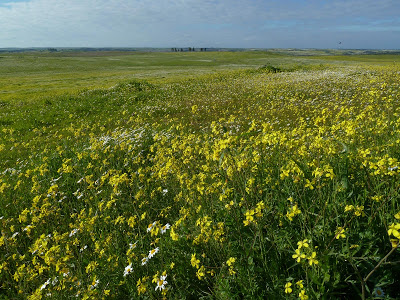
Subscribe to:
Posts (Atom)





